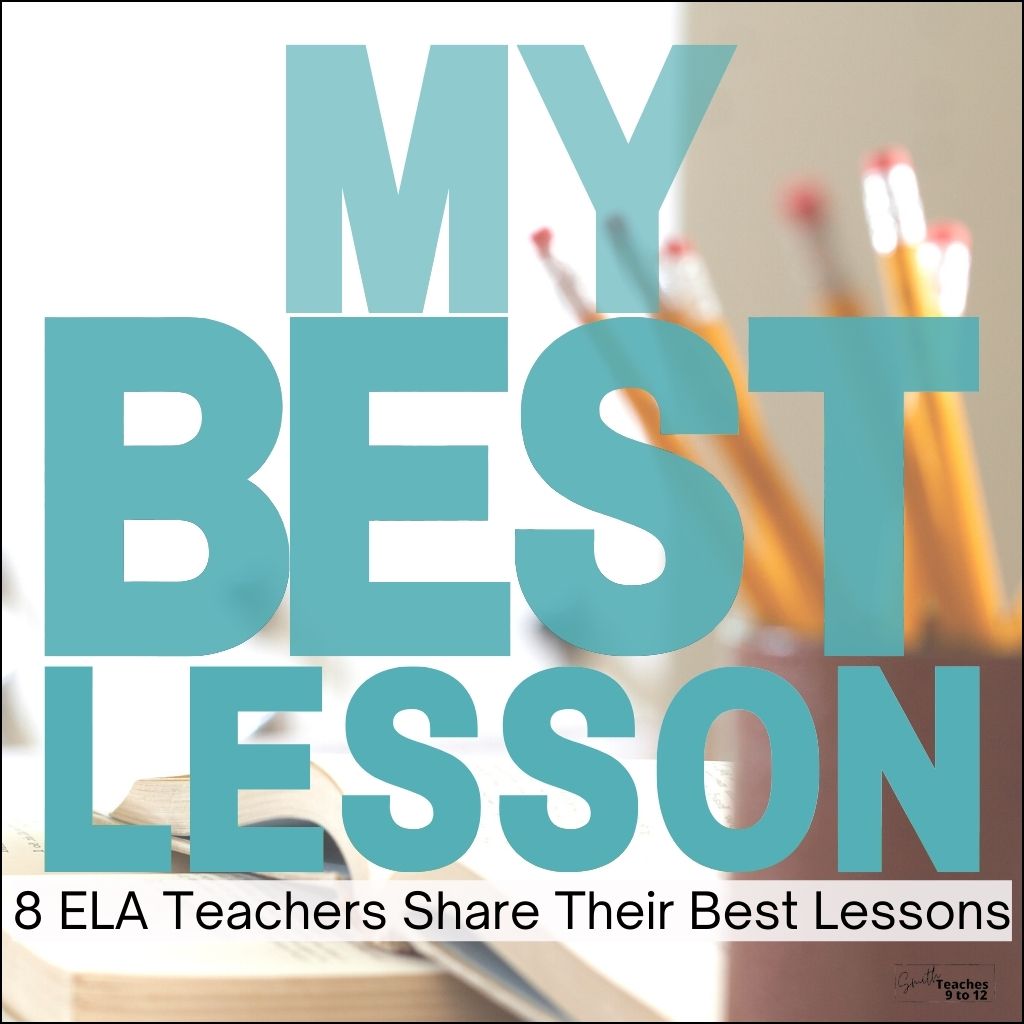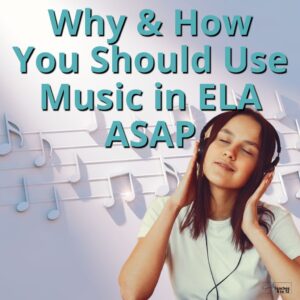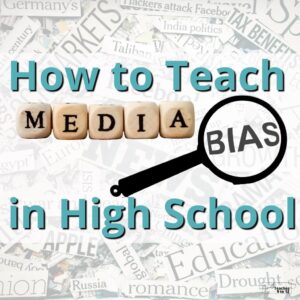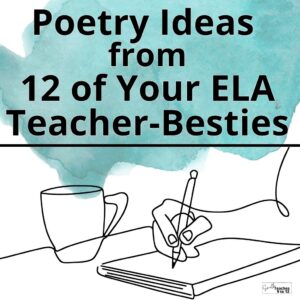Sharing is caring!
Have you ever had a moment of absolute triumph when you finished a lesson in your high school English class? A time where you just thought to yourself: YES, this really, really worked!
Well, I asked seven of my favorite ELA teachers (who you also probably know and love online!) about when they felt this moment of triumph with a lesson plan in their high school English classrooms. I’m happy to say they have shared some absolutely fabulous ideas that you can use in your classroom ASAP!
So keep reading to snag some of the best English lessons from these teacher-besties!
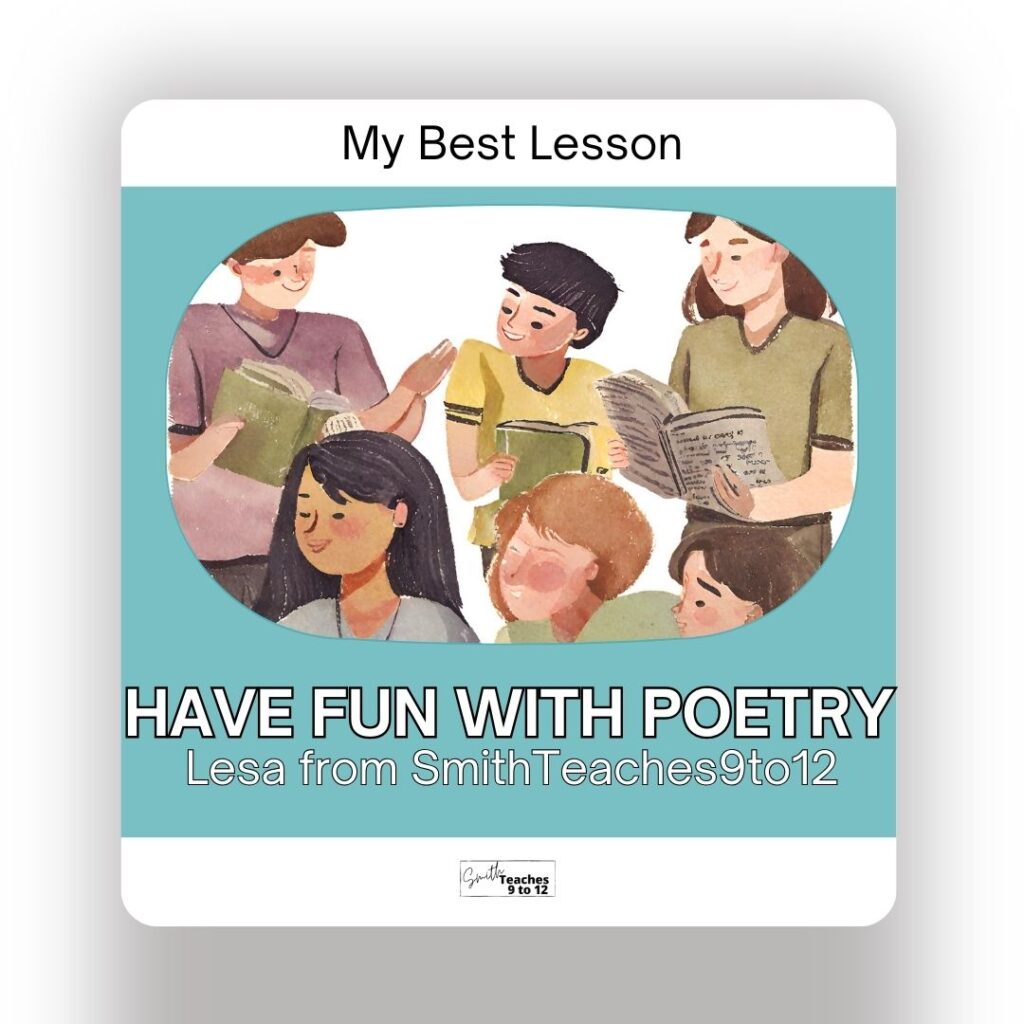
Have Fun With Poetry
You know I love including poetry whenever I can! And poetry is often one of my best lessons, though it wasn’t always that way!
It took time to figure out ways to include it in meaningful ways as well as ways to bring joy to the classroom. I started to combine it with other lessons rather than having it just as an independent unit. Adding poetry to nonfiction lessons or novel and drama studies meant that poetry became less intimidating to my students when it was tackled in its own unit. Demystifying poetry for students (and teachers!) is my goal.
With that in mind, here are my top 3 poetry lesson ideas:
1. Use the power of social media by including Instagram poets such as Rupi Kaur, Nikita Gill, Lang Leav, and Brian Bilston.
You can combine it with analysis with a graphic organizer such as a TP-CASTT (grab a free version and guide here).
Or make it part of a nonfiction and poetry combination with this set of informational articles featuring 6 Instagram Poets and their work.
2. Spoken Word is always a winner with my students! Spend some time with artists such as Sarah Kay, Rudy Francisco (a personal favorite!), or Prince E.A. among others.
Try this freebie featuring “My Honest Poem” by Rudy Francisco and if you want to dive deeper then this week-long unit plan is for you!
3. And finally, include low-pressure poetry such as poetry-focused podcasts to help with listening skills, coloring pages featuring poetry response options to incorporate some SEL, or even a poetry pass activity where students explore the work of a single poet, types of poetry, or even poems that share a common thread!

Examine Fake News
Kristy from 2 Peas and a Dog loves to teach students about fake news and credible sources. In today’s highly digital world and especially now that AI can do so many things – students need to be aware of how to spot fake media creations as well as how to use discernment when interacting with online content.
Start by teaching students the vocabulary of fake news and media literacy. Then, explain what Media Literacy is. This can lead to a great class discussion of various things students have seen in the media. It is always fun to have students examine headlines and look for clickbait and misleading information.
After these lessons, it is important to officially define and explain what fake news is and where it comes from. It is almost important to explain how social media works and how the algorithm impacts what is shown to different audiences.
A fun case study to examine is 1938 The War of the Worlds Radio Broadcast. It is key that students learn about the consequences of spreading misinformation and what can happen when people believe it.
The best part of the fake news lessons I have used with my students is fake news stations. Students work through eight different fake news stations in groups with their peers about satire, websites, videos, news articles, TED talks, social media algorithms, deep fakes, and AI music. Students love working with their peers and examining all these different types of fake items.
Fake news lessons also need to include a lesson on digital citizenship so students can be more aware of their online interactions. You can also have students create their own Fake news assignment to keep them engaged in their learning.
To learn more about why it is important to teach fake news in your classroom check out this blog post.

Create A Dinner Party
Engaging students in writing and research can often be challenging, especially when it comes to finding topics that appeal to everyone. Carolyn, from Middle School Cafe, has created a unit that not only addresses this challenge but also captivates students to the point that they are excited to work on their assignments.
The Dinner Party Research Project offers a creative approach to research and engages students in the research process. In this unique assignment, students plan a dinner party, inviting any five individuals they choose, ranging from historical figures to modern celebrities. This element of choice piques students’ interest in writing, as they connect their personal likes and hobbies with the task of researching their guests.
As the party’s host, students write an introduction to introduce their guests which requires them to have a deep understanding of their guest’s achievements. Because a good party includes great conversation, students formulate thought-provoking questions for their guests, enhancing their critical thinking and inquiry skills.
The Dinner Party Research Project is an example of turning a writing task into an adventure in learning. By allowing students to choose their guests, they dive into research with genuine enthusiasm.
To hear more ideas on how to engage students in writing, listen to this Middle School Cafe podcast episode.

Teach THE Perfect Essay
Amanda from Mud and Ink Teaching once actually experienced teaching the perfect essay. While essay writing might not be every teacher OR students’ favorite lesson, when it goes well, it feels so, so good.
This five-star essay writing experience began with a truly rockstar Essential Question (all units should have a juicy one, and if you’re not there, Amanda teaches all about it). While studying The Great Gatsby, students were focused not on the text only, but on answering the question: Is the American Dream more likely to inspire or destroy?
Throughout the unit, the students were focused on getting to the bottom of this question: which was it? What was it for Gatsby? For Daisy? For Myrtle? Her class looked at poets from the Harlem Renaissance, documentaries about the war, and so much more as they investigated the true experience of chasing the American Dream.
Amanda writes much more extensively about the essay, the prompt, the hands-on outlining experience, and more on her website which you can check out here. For more PD and curriculum writing support, be sure to visit her here!

Do Creative Assessments
When Krista from @whimsyandrigor started to get bored grading the same ol’ post-novel essays, she knew something had to change. If SHE was bored, imagine how the kids felt?!
So, she ditched the typical essay and started doing creative assessments instead. The result? Kids were actually excited to show what they know and Krista stopped being bored to tears. Win win!
Here’s a peek at those creative assessments:
Create an App: If you want students to focus on the PLOT or CONFLICT of a novel, have students create an app that could have benefited a character from the novel. Not only do they design the icon, name it, and explain its purpose but they have to use textual evidence to back up their choices! Here is the resource that Krista uses.
Character in a Bag: If character is a focus of your lesson, have students gather 4-5 physical objects that best represent or are connected to a character and put them into a gift bag. For each object, students must use textual evidence to explain each object’s significance. To take it to the next level, have students sketch images or phrases relevant to the character on the outside of the bag. If you want ready-to-go handouts, check this out.
Character Playlist: This one is always a hit in Krista’s class because so many students love music. The idea is to have students curate a playlist for a character from the novel. They must highlight a lyric that especially connects to a character and choose evidence from the novel to support their choice of song. Krista uses this template for students’ playlists. If time allows (and if the song is clean!) Krista hosts a listening party where students play excerpts of the song for the class and explain its connection.
Reading Check-In: Students thrive when they are given choices, so sometimes Krista gives them 21 options to show off their analytical thinking. Students can choose from using Flip (formerly Flipgrid) to leave a voicemail from one character to another, choose a song that a character would listen to during a specific moment in the text, or record a dramatic reading of a key moment from the novel. If you want to see all 21 options, just click here. If you are ready to stop dreading grading the end-of-novel assessments and are ready to give creative assessments a try, be sure to check out two bundles that Krista created so you have a cache of ready-to-go assessments that students (and you!) can actually enjoy! Bundle of 4 assessment, Bundle of 9 assessments.

Facilitate A Book Tasting
Katie from Mochas and Markbooks loves to promote a love of reading in her students, so her “Tim Bookends” Book Tasting has quickly become her favorite lesson to facilitate in her classroom.
Katie transforms her classroom into a Tim Hortons coffee shop with literary genre signs with a caffeinated vibe, coffee, tea, and donuts to nibble on, and coffee shop music to set the ambiance. While students sip their drinks, they roam around the classroom and “taste” books from different genres by reading the back synopsis and the first page. Students have brochures to fill in for each book they “taste” and the book they give the highest rating is the one they choose to read.
Katie uses this activity as a way for students to choose a book for an independent study unit, but it could also be used for students to choose books for independent reading, or for book clubs.
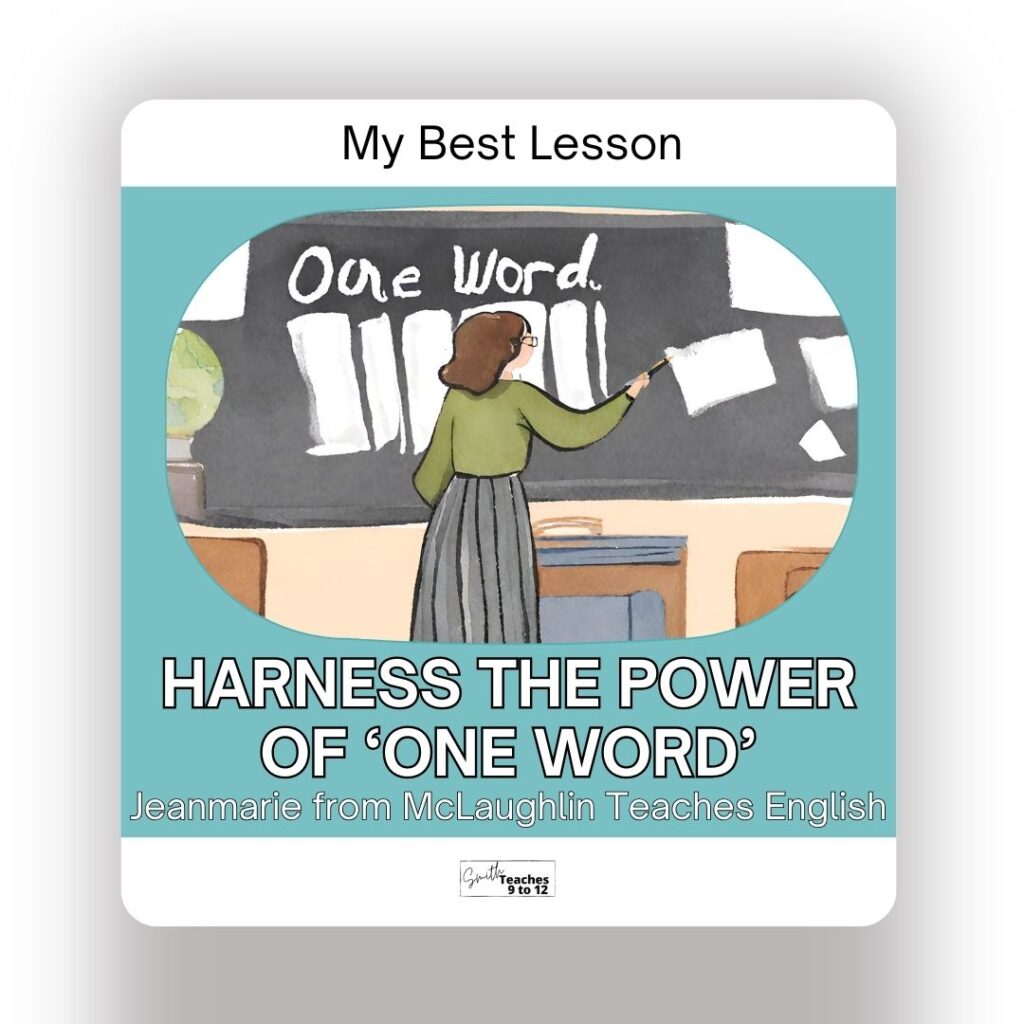
Harness The Power of “One Word”
Jeanmarie from McLaughlin Teaches English loves the power of harnessing “one word.” She is a big fan of “The One Word” project and has made it a whole year-long project where students choose a word in the fall and follow it through to the end of the school year. (Read more about The One Word project here.)
Jeanmarie has learned that one word can actually go a long way. She often has students identify one word about something in a text to help them focus their thinking. She finds this is an effective way to get students discussing characterization, setting, and conflict. Additionally, it is a good way to help students address the idea of theme. (Check here if you would like to try one word discussion starters with Hamlet.)
Recently, Jeanmarie used this idea to help students focus on how authors develop a line of reasoning in a nonfiction text. Students “chunk” the text into 3-5 sections. Then for each section, they identify one word that the section is about. They identify the author’s claim in that part of the text and then use that to trace the line of reasoning. For more on teaching line of reasoning, be sure to check out 3 Line of Reasoning: 3 Activities for AP® Literature.

Hold A Literary Food Truck Rally
Yaddy from Yaddy’s Room loves using literary food trucks in the classroom to create a culture of reading.
Studies have shown that one of the best ways to get student test scores and literacy rates up, they need to read more. When Yaddy was teaching intervention-level English, she noticed that many of her students were just struggling to see the point of reading for fun, struggling to read for a sustained time period, and struggling to understand what they were reading. This led her to try and come up with a project students could complete that would inject some fun back into reading.
With literary food trucks, students are tasked with choosing a book (nonfiction, fiction, manga, or graphic novel, all reading is reading!) and then developing a food truck concept to go with the food truck. Students would:
- Assign restaurant roles and dynamics to characters from their books
- Create a menu related to themes and symbols for the book
- Design a restaurant concept based on the book
- Justify all their decisions and how they relate to the book
Students then presented their projects at the end of the nine weeks in a Food Truck Rally in the library where students from other classrooms were welcome to walk through and see all the books that her students read. Year after year, Yaddy gets comments from parents confiding that this lesson helps make their kids readers again.
Make sure to grab the full, free lesson here.
A Final Word on ‘Best’ Lessons
We hope there’s a lesson in this list that will be best for you and your students.
And we’re always excited to share our ideas and also love to hear yours! So feel free to find each of the ELA teachers in this post on Instagram or visit their websites (links can be found in each of their sections, click their names!) for more of their BEST ideas!

